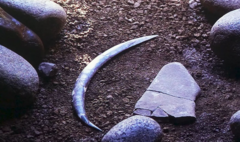A remarkable find in Poland has unveiled the world's oldest known boomerang, radiocarbon-dated to about 40,000 years old. Originally discovered in 1985 in Oblazowa Cave, this exceptional tool is made from mammoth ivory and showcases advanced craftsmanship from prehistoric times.
Despite its familiar curved shape, researchers say this boomerang wouldn't return when thrown; instead, it was likely used for hunting. Dr. Sahra Talamo from the University of Bologna emphasizes its significance, as it provides a glimpse into the skills of early humans, who managed to create such a complex tool thousands of years ago.
Interestingly, while boomerangs are commonly linked to Aboriginal culture in Australia, evidence suggests similar tools existed in various parts of the world, including finds in Europe. The research team, comprised of experts from multiple countries, has published their findings in the journal PLOS One, further enriching the history of ancient human inventions.




















